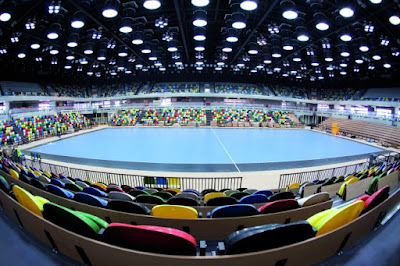Leading lights
Local authorities have cottoned on to the cost benefits of LED lighting in our streets, and in government owned buildings across their portfolio. But to what extent can LEDs help squeezed budgets? Society of Light and Lighting Secretary Brendan Keely takes a look.
Just under a year ago, the UK Government affirmed its
commitment to the 5th Carbon Budget which binds it to a target of 57%
cut in carbon emissions by 2032 – with a view to an 80% cut by 2050. This is a
refreshingly ambitious target, but according to Dr Hywel Davies of the
Chartered Institution of Building Services Engineers (CIBSE) it will mean that
the Government must maintain all of its current climate policies and find
further ways to make cuts if it is to stand any chance of hitting this goal.
This means the Government is going to have to get creative in order to eke out
savings above and beyond what it is already doing.
Last year I wrote that
a great way of cutting down on emissions is to target the 180,000 government
owned buildings in the UK, two-thirds of which are run by local authorities –
encouraging them to switch to properly designed and specified LED lighting solutions
in order to save money and carbon.
 |
| LEDs can save councils money on energy costs in contexts from streets to stadia |
Since that article was published, local authorities across
the UK have been rolling out LEDs en-masse for their environmental and
budgetary benefits, in new builds, as part of retrofits, on motorways and in
street lighting. With most local councils aiming to replace all of their
sodium-based street lighting with LED alternatives gradually over the next
decade, LED will soon be a fixture just about everywhere.
Much has been made of the great efficiency savings that can
be made with LED technology – since the year 2000 LED lights have become ten
times more efficient and can boast far longer lifespans than even the most
advanced fluorescent lights. Combined with other measures to boost efficiency,
such as controls systems, LED solutions can represent a step-change in the
efficiency of a building’s lighting – up to 80% savings in some cases.
The maths also looks good from a lifetime perspective as
well – a combination of a long life, energy efficiency and low maintenance
costs are a great asset to facilities managers worried about the overall cost
of a new technology. In this vein, they are also easy to integrate into
existing energy management systems: They can easily be set to dim automatically
or turn off altogether to reflect the number of people in a room, the time of
day or the time of year. This applies on the scale of a single room, a whole
building, a stretch of road or a whole town, and can save money without
jeopardising safety because their efficiency actually increases when they are
dimmed.
 |
| Local authorities can make savings across their building portfolio |
The energy and carbon savings possible with LED lights are
well documented, and local government has bought into their potential on a
large scale – but simply seeing LED as a cheaper, newer replacement for
fluorescent lights that tick a few green boxes seriously underestimates their
other benefits.
At the recent CIBSE Technical Symposium, Ashley Bateson of
Hoare Lea observed that only 1% of the cost of running a business is energy
related while 9% is rental and a massive 90% is staff costs. The health and
wellbeing of the occupants who live and work in a building is hugely important
to a company’s bottom-line, because staff absence and illness costs more than
any amount of inefficiency, but it can’t be easily measured on a meter so is
often overlooked.
The effects of the built environment on health are numerous,
complex and touch just about every element of a building. Just sitting next to
an open window can reduce a staff member’s sick days by as much as 6%, for
example, and higher CO2 concentrations can reduce student’s cognitive
performance by 72%. Lighting is no exception to this.
 |
| Artificial light is known to affect the human circadian rhythm |
The most well-known application of lighting to wellbeing is in the human Circadian Rhythm - the biological processes that regulate our waking and sleeping hormones. Since researchers discovered that this cycle is greatly affected by light, when less light enters the eye it tells our brains that it’s dark and time to sleep or when brighter time to wake up, much has been made of the role of artificial light in this process. Too much blue light in the evening can fool the body into thinking that it’s day time – thereby interfering with the natural sleep cycle.
Daylight remains the most effective means of keeping the
Circadian Rhythm in check, but with the advent of LED lights that can mimic a
range of colours and intensities it is increasingly able to replicate natural changes
in the spectral distribution of the light to mimic natural light, to the extent
that it can offset the damage to mood and sleep cycles linked to prolonged periods
in doors. The light changes colour during the day – from colder blue light in
the afternoon when we need a boost to be active to warmer colour temperature
light in the evening when we’re resting. In the winter months when it gets dark
early, it could even mean the difference between a well-rested workforce and a
tired one.
The versatility of LED technology also allows designers to
create bespoke solutions that create a balance between the light’s usefulness
and its impact on health. Obviously a workplace needs to be well-lit enough to
be safe and functional, but the impact of lighting too intensely from above can
be anything from eye pain caused by glare or flicker. It can even make a room
harder to see, by creating dark areas where there isn’t a balanced light distribution.
Using control systems in conjunction with LEDs, it is possible to reduce these
problems by setting light intensity to match the local requirements, and allow
office users to choose their own settings for comfort. Even the ability to
adjust lighting levels gives building users a psychological boost that lowers
absenteeism and increases productivity.
 |
| LED light can be produced in a variety of colours to mimic the day/night cycle |
LED lighting is crucial here because they not only produce
light, but the right kind of light for a workplace environment. There are
numerous studies that link brighter offices with increased productivity,
motivation and enhanced wellbeing. The flexibility of LEDs not only allows us
to light the room more effectively, but with the right kind of light to ensure
the lease disruption.
While the savings attributable to energy efficiency caused
by the switch to LED lighting is great for local authorities, it really only
scratches the surface of what is possible for the whole range of publically
owned buildings – from workplaces to leisure facilities, schools, hospitals and
libraries. A 1% increase in productivity or health of employees can far
outweigh all of the savings achieve through efficiency. But it’s all down to how LEDs are
implemented and deployed within buildings.
In order to ensure that the technology is properly utilised
so that it is as effective and efficient as possible, local councils will have
to ensure that it is professionally designed as part of a wider strategy that
bakes efficiency into the design of their buildings. It’s not as simple as
replacing one technology with another like-for-like: it needs to be properly designed
and installed by an engineer or designer following industry guidance, such as
that produced by the Society of Light and Lighting and the Chartered
Institution of Building Services Engineers, to be as effective
as it can be, and ensure that works harmoniously with the building, the
occupants and the other systems in play.
.png)


Comments
Post a Comment